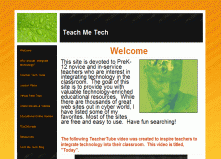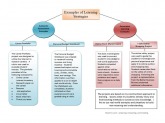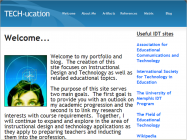Artifacts...
This is my artifacts in the area of instructional design and technology applications as they apply to preparing teachers and inducting them into the profession.
Web-Enhanced Learning Lesson Plan Project

This lesson plan was designed and developed using web-enhanced learning. The title, "Saving...What is it worth?" incorporates textual, informational, and visual literacy as well as 21st century skills. Using the Research Cycle, the learners will move through the problem-solving model to research the different types of savings, guidelines for saving, and facts about saving. The creation of the electronic brochure will assist in demonstrating the learner's knowledge and understanding of the unit's objectives as well as the technology standards.
This project helped me apply, analyze, synthesize, and evaluate my pedagogical practices. In addition, I was able to implement some of the content gained form this course (e.g. Research Cycle). In the future, I would like to integrate more web-enhanced learning lesson plans with detail given to technology standards.
Professional Resource Project

The Professional Resource Project is designed for PreK-12 novice and in-service teachers who are interested in integrating technology in the classroom. The goal of the web site is to provide educators with valuable technology-enriched educational resources.
Creating this type of project has taught me how to narrow my scope and sequence for a specific topic. While technology integration is a pretty broad subject, I have worked at providing indepth resources to help teachers. Within this project, I have learned how to embed different types of Web 2.0 multi-media tools. In the future, I plan to take some of the lesson plan ideas created on this site, and incorporate them into the Teach Me Tech site.
Reflections on Theories and Strategies for Active Learning

The purpose of this assignment was to write/develop a summative reflection on theories and strategies with consideration on my past and future approaches to teaching and learning.
Reflecting on theories and strategies for active learning has made me think about my own teaching practices. Most of my reflection has been on my ability to plan higher order thinking skills for different learning strategies. For the future, I would like to find and create different learning strategies for diverse learners.
10 Best Uses of the Internet
What are the 10 best uses of the Internet? Everyone has their own opinion and so do I. Check out my top 10.
10 best uses of the Internet is designed to incorporate a new (to me) Web 2.0 tool as well as my top 10 list that I could use if I were to teach a professional development workshop.
This project was beneficial to my acadmic studies. First of all, I learned how to use SmileBox. I have never used this tool before and it worked well for my needs. Second, I really had to think about my best uses for the Internet. Through my research, I found new sites that I could use in future projects. Moving forward, I could see how my 10 best uses would change throughout my program of study. I am interested what other people have to say is their best use of the Internet...this will be my next blog post.
Reflections on Literacy in the Information Age Project
Literacy in the Information Age goes well beyond traditional teaching methods and bounded text. Conventional literacy skills consisting of reading, writing, listening, and speaking are being integrated with new age literacy skills (Anderson et al., 2008). Educational literacy in the Information Age is gravitating towards a complex way of teaching and learning such as integrating technological tools, collaborating online, researching information from multiple sources and creating multi-media projects (NCTE, 2008).
During my first year in the teaching profession I was expected to plan lessons that fused traditional teaching methods with technology, computer and Internet literacy skills. The lessons I developed incorporated many of the information literacy skills defined by Bishop (2003) such as recognizing the need for information, locating sources, researching appropriate sources, organizing and creating the information into applicable knowledge.
This slide show provides three lesson ideas for how a teacher can integrate literacy in the Information Age with references noted at the end. Based on this project, I was able to learn how to use and embed Zoho documents as well as reflect on Information Age literacies. The readings provided me with insight I have hear but never thought about indepth. I definitely use the knowledge gained from this project for future IDT coursework. Literacy is important and demonstrating the different types of literacy is vital.
Search and Retrieve

Interested in finding a great educational search engine or sites on technology integration? Cick on the diigo icon and visit my bookmarks and add your favorite educational sites.
The purpose of this project is to compare search engines, directories and metasearches and collect a variety of bookmarked sites for searching and technology integration.
The Search and Retrieve project assisted in my understanding of social bookmarking and tags. I was able to learn about Diigo and how to create and share special sites. I choose Diigo because it is user-friendly and many of my peers use it as well. I foresee using Diigo for more bookmarking sites and creating helpful notes about each site.
Reflections on Integrating the Internet Safely and Ethically
The purpose of this project is to develop a summative reflection on integrating the Internet safely and ethically while considering my past and future approaches to teaching and learning. Overall, this reflection has caused me to think about my Internet practices, Internet safety, my previous school's Internet policy and my future technology enriched lessons. In the past, I had prevented problems by permitting my students to search approved sites. In retrospect, I should have given them more freedom that would give them a wider range of educational material. I have learned that with proper guidelines and web site evaluation, students should have the opportunity to search beyond my recommend sites.
My reflection on integrating the Internet safely and ethically...
Using the Internet has become a large part of my life. I don’t know what I would do without it and I often wonder how we survived 20 years ago. Today, I use the Internet for many things such as researching, shopping, communicating, publishing, watching videos, listening to music, looking for artwork, and blogging. I have a love-hate relationship with the Internet. I like the idea of not being forced to trek across campus to the library. Don't get me wrong, the library is an excellent place to find and retrieve academic resources but I can do most of my research in the comfort of my own space. Searching the Internet can cause me to lose track of time only to realize I have lost half of the day. Sure, it is a great feeling to find a bargain online but in order to find the best deal; I will spend hours searching only to realize that the first site I visited was the best deal to begin with.
More on my reflection...
Reflections on Web 2.0
This project required my ability to analyze my current practice and consider the impacts on my future practice. In addition, I created three lesson ideas from the Web 2.0 unit.
The Read Write Web, affectionately known as Web 2.0 has changed my educational life is so many positive ways. My Web 2.0 experience will have a huge impact on my coursework and teaching. I am able to implement web applications in my course projects such as a digital video on Google Video and a slide show on SlideShare. As a teacher, it will play a large role in the way I teach and how students learn. In my classroom and coursework, my students and I will be able to publish, share and collaborate via the Internet. In the future, I will learn more about Web 2.0 tools and find ways to integrate the new technologies into my lessons.
Reflections on Web 2.0 Blog Post
Lesson Ideas for Evaluating Information Project
The evaluating information project demonstrates my thoughts into three lessons ideas for integrating technology and techniques. Based on the readings, I implemented into my lesson plans the Big6 Skills, Info Savvy, and the Research Cycle.
Prior to this class, I did not know a lot about integrating techniques for evaluating infromation. Today, I feel more confident with my ability to use problem-solving models and evaluation techniques for web-enhanced learning. In the future, I will use the lesson ideas for future projects and implement the models in various lessons.
Lesson Ideas for Evaluating Information Project Blog Post


